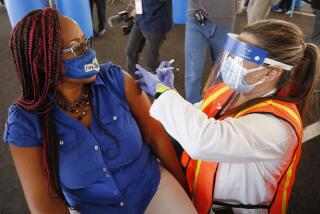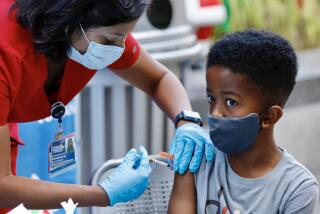L.A. County set to open five new COVID-19 vaccination sites, aiming for 20,000 shots per day
Five large COVID-19 vaccination sites are slated to open next week in Los Angeles County as public health officials accelerate preparations for an expected surge in demand after this week’s expansion of the vaccine eligibility list to residents 65 and older.
The sites are Pomona Fairplex, the Forum in Inglewood, Cal State Northridge, the L.A. County Office of Education in Downey and Six Flags Magic Mountain in Valencia.
The openings come at a crucial time. Though residents 65 and older are now on the state’s vaccine priority list, they cannot actually receive the shots until the county first vaccinates some 500,000 healthcare workers. Officials hope to achieve that goal by the end of the month.
“In L.A. County we have to vaccinate 10 million people, twice,” said Supervisor Janice Hahn. “These large-scale vaccination sites are going to help us get there by massively increasing our capacity to vaccinate people quickly and efficiently.”
Each site is expected to vaccinate 4,000 people a day. Appointments and proof of employment in the healthcare industry will be required to get the shot, the county said. The five sites are expected to remain open for at least four weeks. They are run separately from the city’s Dodger Stadium vaccine site.
The county plans to vaccinate roughly 4,000 people per day at each site. While there is enough supply to do so initially, officials say they need more to vaccinate some 500,000 healthcare workers.
“We’re not done with our healthcare workers,” L.A. County Public Health Director Barbara Ferrer said Wednesday, adding that the county has asked the state for more doses. “We haven’t heard back from the state about vaccine availability and how it would be distributed.”
The need for more vaccine has been echoed in other counties. To date, the state has received more than 3 million vaccine doses and has administered roughly one-third.
The rapid expansion of mass vaccination sites helps ensure the county’s capacity to distribute the vaccines when supply increases, Kevin McGowan, director of the office of emergency management, told The Times on Friday.
“What we control is our capacity to push product out when it gets to us, and that’s what our focus point is going to be is building out the biggest, most robust capability, so that when we get vaccinations, we have the infrastructure in place to effectively push them out in a timely manner,” McGowan said.
“It’s a collaborative experience that would benefit us all if everyone is rowing in the same boat in the same direction,” McGowan said.
Los Angeles County officials are asking residents both with and without medical training to consider volunteering at one of the county’s mass vaccination sites. Clinical volunteers will administer vaccines while administrative volunteers will help with traffic and supplies.
The operation also requires a plan to save any potential leftover doses.
Dr. Paul Simon, chief science officer in L.A. County, said during a media briefing Friday that staff at the five mass vaccine sites launching in the county will be trained to follow the flow of traffic at the site and open only the necessary number of vials.
Each vial holds about five or six vaccine doses. Once opened, the use-it-or-lose-it time frame narrows to about six hours.
In the event there is a vaccine surplus, Simon said that staff is also being instructed to reach out within the local communities to first offer the doses to the most vulnerable.
“We want to prioritize those higher-risk groups,” he said.
The leftover vaccine may also be administered to site volunteers or others within the community in order to save all leftover doses.
“No vaccines are being thrown out,” Simon said. “There have been isolated reports of some vaccines being lost at the end of the day ... That’s tragic. We don’t want that to happen. We have protocols in place to try to prevent that. But certainly mass quantities of vaccine are not being lost.”
More to Read
Sign up for Essential California
The most important California stories and recommendations in your inbox every morning.
You may occasionally receive promotional content from the Los Angeles Times.












